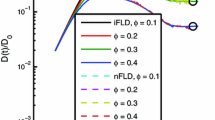Abstract.
We report results of numerical simulations of complex fluids, using a combination of discrete-particle methods. Our molecular modeling repertoire comprises three simulation techniques: molecular dynamics (MD), dissipative particle dynamics (DPD), and the fluid particle model (FPM). This type of model can depict multi-resolution molecular structures (see the Figure) found in complex fluids ranging from single micelle, colloidal crystals, large-scale colloidal aggregates up to the mesoscale processes of hydrodynamical instabilities in the bulk of colloidal suspensions. We can simulate different colloidal structures in which the colloidal beds are of comparable size to the solvent particles. This undertaking is accomplished with a two-level discrete particle model consisting of the MD paradigm with a Lennard-Jones (L-J) type potential for defining the colloidal particle system and DPD or FPM for modeling the solvent. We observe the spontaneous emergence of spherical or rod-like micelles and their crystallization in stable hexagonal or worm-like structures, respectively. The ordered arrays obtained by using the particle model are similar to the 2D colloidal crystals observed in laboratory experiments. The micelle shape and its hydrophobic or hydrophilic character depend on the ratio between the scaling factors of the interactions between colloid–colloid to colloid–solvent. Unlike the miscellar arrays, the colloidal aggregates involve the colloid–solvent interactions prescribed by the DPD forces. Different from the assumption of equilibrium growth, the two-level particle model can display much more realistic molecular physics, which allows for the simulation of aggregation for various types of colloids and solvent liquids over a very broad range of conditions. We discuss the potential prospects of combining MD, DPD, and FPM techniques in a single three-level model. Finally, we present results from large-scale simulation of the Rayleigh–Taylor instability and dispersion of colloidal slab in 2D and 3D. Electronic supplementary material to this paper can be obtained by using the Springer LINK server located at http://dx.doi.org/10.1007/s00894-001-0068-3.
Similar content being viewed by others
Author information
Authors and Affiliations
Electronic Supplementary Material
Rights and permissions
About this article
Cite this article
Dzwinel, W., Yuen, D. & Boryczko, K. Mesoscopic dynamics of colloids simulated with dissipative particle dynamics and fluid particle model. J Mol Model 8, 33–43 (2002). https://doi.org/10.1007/s00894-001-0068-3
Received:
Accepted:
Published:
Issue Date:
DOI: https://doi.org/10.1007/s00894-001-0068-3




